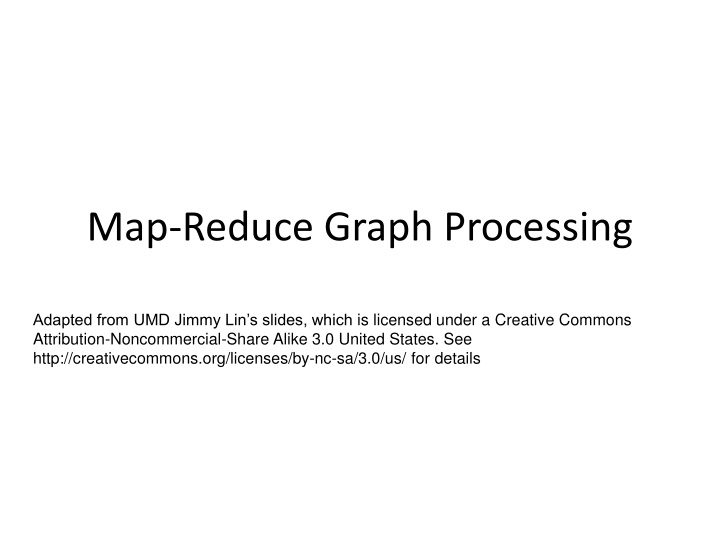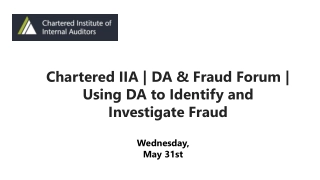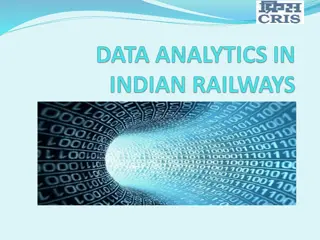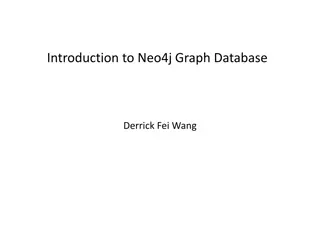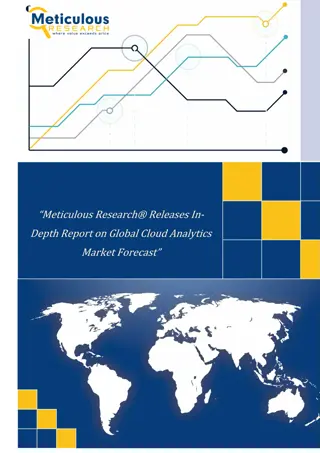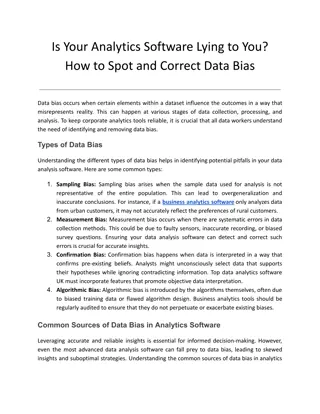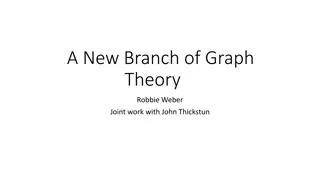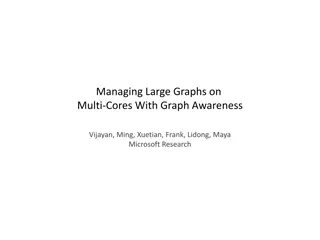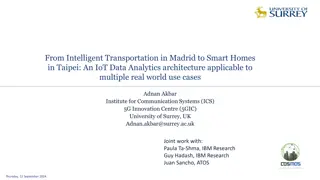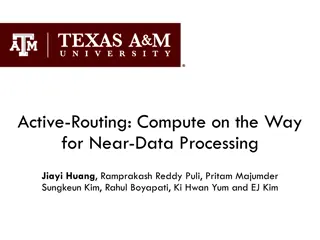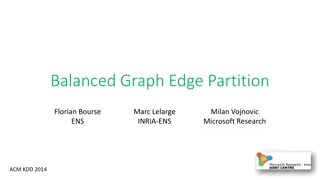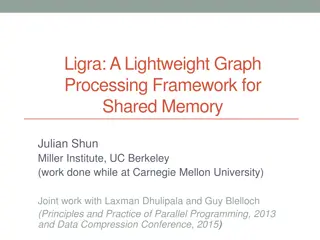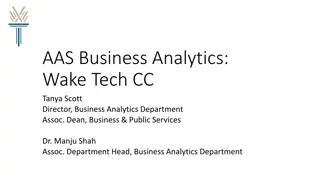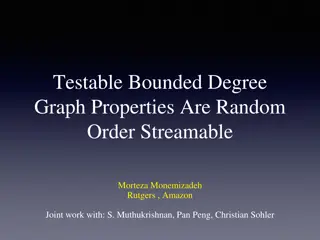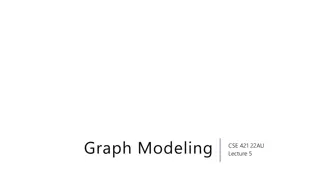Graph Processing and Network Analytics
Graph processing involves solving various problems related to graphs, such as finding shortest paths, routing internet traffic, and identifying special nodes. This type of data processing is essential in areas like social networks, biological networks, and transportation networks. Additionally, graph analytics help in understanding the structure and relationships within data, enabling tasks like ranking webpages, determining network connectivity, and detecting anomalies. With the ubiquity of network data, graph processing plays a crucial role in extracting valuable insights and optimizing network operations across different domains.
Download Presentation

Please find below an Image/Link to download the presentation.
The content on the website is provided AS IS for your information and personal use only. It may not be sold, licensed, or shared on other websites without obtaining consent from the author.If you encounter any issues during the download, it is possible that the publisher has removed the file from their server.
You are allowed to download the files provided on this website for personal or commercial use, subject to the condition that they are used lawfully. All files are the property of their respective owners.
The content on the website is provided AS IS for your information and personal use only. It may not be sold, licensed, or shared on other websites without obtaining consent from the author.
E N D
Presentation Transcript
Map-Reduce Graph Processing Adapted from UMD Jimmy Lin s slides, which is licensed under a Creative Commons Attribution-Noncommercial-Share Alike 3.0 United States. See http://creativecommons.org/licenses/by-nc-sa/3.0/us/ for details
Roadmap Graph problems and representations Parallel breadth-first search PageRank
Whats a graph? G = (V,E), where V represents the set of vertices (nodes) E represents the set of edges (links) Both vertices and edges may contain additional information Different types of graphs: Directed vs. undirected edges Presence or absence of cycles Graphs are everywhere: Hyperlink structure of the Web Physical structure of computers on the Internet Interstate highway system Social networks
Some Graph Problems Finding shortest paths Routing Internet traffic and UPS trucks Finding minimum spanning trees Telco laying down fiber Finding Max Flow Airline scheduling Identify special nodes and communities Breaking up terrorist cells, spread of avian flu Bipartite matching Monster.com, Match.com And of course... PageRank
Ubiquitous Network (Graph) Data Social Network Biological Network Road Network/Map WWW Sematic Web/Ontologies XML/RDF . Semantic Search, Guha et. al., WWW 03 http://belanger.wordpress.com/2007/06/28/ the-ebb-and-flow-of-social-networking/ 6
Graph (and Relational) Analytics General Graph Count the number of nodes whose degree is equal to 5 Find the diameter of the graphs Web Graph Rank each webpage in the webgraph or each user in the twitter graph using PageRank, or other centrality measure Transportation Network Return the shortest or cheapest flight/road from one city to another Social Network Determine whether there is a path less than 4 steps which connects two users in a social network Financial Network Find the path connecting two suspicious transactions; Temporal Network Compute the number of computers who were affected by a particular computer virus in three days, thirty days since its discovery
Challenge in Dealing with Graph Data Flat Files No Query Support RDBMS Can Store the Graph Limited Support for Graph Query Connect-By (Oracle) Common Table Expressions (CTEs) (Microsoft) Temporal Table
Native Graph Databases Emerging Field http://en.wikipedia.org/wiki/Graph_database Storage and Basic Operators Neo4j (an open source graph database) InfiniteGraph VertexDB Distributed Graph Processing (mostly in- memory-only) Google s Pregel (vertex centered computation)
Graph analytics industry practice status Graph data in many industries Graph analytics are powerful and can bring great business values/insights Graph analytics not utilized enough in enterprises due to lack of available platforms/tools (except leading tech companies which have high caliber in house engineering teams and resources)
Graphs and MapReduce Graph algorithms typically involve: Performing computations at each node: based on node features, edge features, and local link structure Propagating computations: traversing the graph Key questions: How do you represent graph data in MapReduce? How do you traverse a graph in MapReduce?
Representing Graphs G = (V, E) Two common representations Adjacency matrix Adjacency list
Adjacency Matrices Represent a graph as an n x n square matrix M n = |V| Mij = 1 means a link from node i to j 2 1 0 1 1 1 2 1 0 0 0 3 0 1 0 1 4 1 1 0 0 1 2 3 4 1 3 4
Adjacency Matrices: Critique Advantages: Amenable to mathematical manipulation Iteration over rows and columns corresponds to computations on outlinks and inlinks Disadvantages: Lots of zeros for sparse matrices Lots of wasted space
Adjacency Lists Take adjacency matrices and throw away all the zeros 1 0 1 1 1 2 1 0 0 0 3 0 1 0 1 4 1 1 0 0 1 2 3 4 1: 2, 4 2: 1, 3, 4 3: 1 4: 1, 3
Adjacency Lists: Critique Advantages: Much more compact representation Easy to compute over outlinks Disadvantages: Much more difficult to compute over inlinks
Single Source Shortest Path Problem: find shortest path from a source node to one or more target nodes Shortest might also mean lowest weight or cost First, a refresher: Dijkstra s Algorithm
Dijkstras Algorithm Example 1 10 9 2 3 4 6 0 7 5 2 Example from CLR
Dijkstras Algorithm Example 1 10 10 9 2 3 4 6 0 7 5 5 2 Example from CLR
Dijkstras Algorithm Example 1 8 14 10 9 2 3 4 6 0 7 5 5 7 2 Example from CLR
Dijkstras Algorithm Example 1 8 13 10 9 2 3 4 6 0 7 5 5 7 2 Example from CLR
Dijkstras Algorithm Example 1 1 8 9 10 9 2 3 4 6 0 7 5 5 7 2 Example from CLR
Dijkstras Algorithm Example 1 8 9 10 9 2 3 4 6 0 7 5 5 7 2 Example from CLR
Single Source Shortest Path Problem: find shortest path from a source node to one or more target nodes Shortest might also mean lowest weight or cost Single processor machine: Dijkstra s Algorithm MapReduce: parallel Breadth-First Search (BFS)
Finding the Shortest Path Consider simple case of equal edge weights Solution to the problem can be defined inductively Here s the intuition: Define: b is reachable from a if b is on adjacency list of a DISTANCETO(s) = 0 For all nodes p reachable from s, DISTANCETO(p) = 1 For all nodes n reachable from some other set of nodes M, DISTANCETO(n) = 1 + min(DISTANCETO(m), m M) d1 m1 d2 s n m2 d3 m3
Visualizing Parallel BFS n7 n0 n1 n2 n3 n6 n5 n4 n8 n9
From Intuition to Algorithm Data representation: Key: node n Value: d (distance from start), adjacency list (list of nodes reachable from n) Initialization: for all nodes except for start node, d = Mapper: m adjacency list: emit (m, d + 1) Sort/Shuffle Groups distances by reachable nodes Reducer: Selects minimum distance path for each reachable node Additional bookkeeping needed to keep track of actual path
Multiple Iterations Needed Each MapReduce iteration advances the known frontier by one hop Subsequent iterations include more and more reachable nodes as frontier expands Multiple iterations are needed to explore entire graph Preserving graph structure: Problem: Where did the adjacency list go? Solution: mapper emits (n, adjacency list) as well
Stopping Criterion How many iterations are needed in parallel BFS (equal edge weight case)? Convince yourself: when a node is first discovered , we ve found the shortest path Now answer the question... Six degrees of separation? Practicalities of implementation in MapReduce
Comparison to Dijkstra Dijkstra s algorithm is more efficient At any step it only pursues edges from the minimum-cost path inside the frontier MapReduce explores all paths in parallel Lots of waste Useful work is only done at the frontier Why can t we do better using MapReduce?
Weighted Edges Now add positive weights to the edges Why can t edge weights be negative? Simple change: adjacency list now includes a weight w for each edge In mapper, emit (m, d + wp) instead of (m, d + 1) for each node m That s it?
Stopping Criterion How many iterations are needed in parallel BFS (positive edge weight case)? Convince yourself: when a node is first discovered , we ve found the shortest path
Additional Complexities 1 search frontier 1 1 n6 n7 n8 10 r n9 1 n5 n1 1 1 s q p n4 1 1 n2 n3
Stopping Criterion How many iterations are needed in parallel BFS (positive edge weight case)? Practicalities of implementation in MapReduce
Graphs and MapReduce Graph algorithms typically involve: Performing computations at each node: based on node features, edge features, and local link structure Propagating computations: traversing the graph Generic recipe: Represent graphs as adjacency lists Perform local computations in mapper Pass along partial results via outlinks, keyed by destination node Perform aggregation in reducer on inlinks to a node Iterate until convergence: controlled by external driver Don t forget to pass the graph structure between iterations
http://famousphil.com/blog/2011/06/a-hadoop-mapreduce-solution-to-dijkstra%E2%80%99s-algorithm/http://famousphil.com/blog/2011/06/a-hadoop-mapreduce-solution-to-dijkstra%E2%80%99s-algorithm/ public class Dijkstra extends Configured implements Tool { public static String OUT = "outfile"; public static String IN = "inputlarger ; public static class TheMapper extends Mapper<LongWritable, Text, LongWritable, Text> { public void map(LongWritable key, Text value, Context context) throws IOException, InterruptedException { Text word = new Text(); String line = value.toString();//looks like 1 0 2:3: String[] sp = line.split(" ");//splits on space int distanceadd = Integer.parseInt(sp[1]) + 1; String[] PointsTo = sp[2].split(":"); for(int i=0; i<PointsTo.length; i++){ word.set("VALUE "+distanceadd);//tells me to look at distance value context.write(new LongWritable(Integer.parseInt(PointsTo[i])), word); word.clear(); } //pass in current node's distance (if it is the lowest distance) word.set("VALUE "+sp[1]); context.write( new LongWritable( Integer.parseInt( sp[0] ) ), word ); word.clear(); word.set("NODES "+sp[2]);//tells me to append on the final tally context.write( new LongWritable( Integer.parseInt( sp[0] ) ), word ); word.clear(); }
public static class TheReducer extends Reducer<LongWritable, Text, LongWritable, Text> { public void reduce(LongWritable key, Iterable<Text> values, Context context) throws IOException, InterruptedException { String nodes = "UNMODED"; Text word = new Text(); int lowest = 10009;//start at infinity for (Text val : values) {//looks like NODES/VALUES 1 0 2:3:, we need to use the first as a key String[] sp = val.toString().split(" ");//splits on space //look at first value if(sp[0].equalsIgnoreCase("NODES")){ nodes = null; nodes = sp[1]; }else if(sp[0].equalsIgnoreCase("VALUE")){ int distance = Integer.parseInt(sp[1]); lowest = Math.min(distance, lowest); } } word.set(lowest+" "+nodes); context.write(key, word); word.clear(); } }
public int run(String[] args) throws Exception { //http://code.google.com/p/joycrawler/source/browse/NetflixChallenge/src/org/niubility/learning/knn/KNNDriver.ja va?r=242 getConf().set("mapred.textoutputformat.separator", " ");//make the key -> value space separated (for iterations .. while(isdone == false){ Job job = new Job(getConf()); job.setJarByClass(Dijkstra.class); job.setJobName("Dijkstra"); job.setOutputKeyClass(LongWritable.class); job.setOutputValueClass(Text.class); job.setMapperClass(TheMapper.class); job.setReducerClass(TheReducer.class); job.setInputFormatClass(TextInputFormat.class); job.setOutputFormatClass(TextOutputFormat.class); FileInputFormat.addInputPath(job, new Path(infile)); FileOutputFormat.setOutputPath(job, new Path(outputfile)); success = job.waitForCompletion(true); //remove the input file //http://eclipse.sys-con.com/node/1287801/mobile if(infile != IN){ String indir = infile.replace("part-r-00000", ""); Path ddir = new Path(indir); FileSystem dfs = FileSystem.get(getConf()); dfs.delete(ddir, true); }
Random Walks Over the Web Random surfer model: User starts at a random Web page User randomly clicks on links, surfing from page to page PageRank Characterizes the amount of time spent on any given page Mathematically, a probability distribution over pages PageRank captures notions of page importance Correspondence to human intuition? One of thousands of features used in web search Note: query-independent
PageRank: Defined Given page x with inlinks t1 tn, where C(t) is the out-degree of t is probability of random jump N is the total number of nodes in the graph ( ) 1 n PR t = i = + ( ) 1 ( ) i ) PR x ( N C t 1 i t1 X t2 tn
Example: The Web in 1839 y a m Yahoo y 1/2 1/2 0 a 1/2 0 1 m 0 1/2 0 Amazon M soft
Simulating a Random Walk Start with the vector v= [1,1, ,1] representing the idea that each Web page is given one unit of importance. Repeatedly apply the matrix M to v, allowing the importance to flow like a random walk. Limit exists, but about 50 iterations is sufficient to estimate final distribution.
Example Equations v= M v: y = y /2 + a /2 a = y /2 + m m = a /2 y a = m 1 1 1 1 3/2 1/2 5/4 1 3/4 9/8 11/8 1/2 6/5 6/5 3/5 . . .
Solving The Equations Because there are no constant terms, these 3 equations in 3 unknowns do not have a unique solution. Add in the fact that y +a +m = 3 to solve. In Web-sized examples, we cannot solve by Gaussian elimination; we need to use relaxation (= iterative solution).
Real-World Problems Some pages are dead ends (have no links out). Such a page causes importance to leak out. Other (groups of) pages are spider traps (all out-links are within the group). Eventually spider traps absorb all importance.
Microsoft Becomes Dead End y a m Yahoo y 1/2 1/2 0 a 1/2 0 0 m 0 1/2 0 Amazon M soft
Example Equations v= M v: y = y /2 + a /2 a = y /2 m = a /2 y a = m 1 1 1 1 1/2 1/2 3/4 1/2 1/4 5/8 3/8 1/4 0 0 0 . . .
